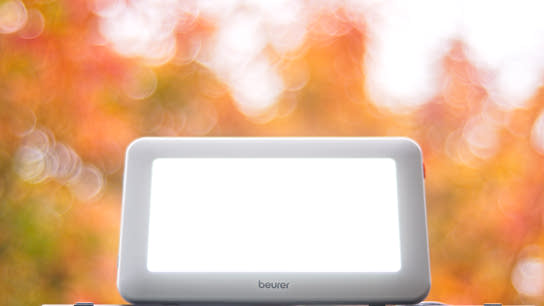Here’s my review of the Beurer TL20 (2018-model) daylight therapy lamp. I’ve used an older model called Beurer TL30 from 2014 every autumn and winter for the last six years. For me, the treatment is difference between feeling tired throughout winter or not getting out of bed at all. It’s not perfect, but its something that makes a significant difference. As a baseline, I’ll share my years of experiences with the TL30 and then discuss the TL20.
Daylight is dwindling and the days are getting shorter in the northern hemisphere. I’ve had seasonal affective disorder (SAD), more commonly known as “winter depression/blues”, as far back as I can remember. Treatment consists of staring into a bright light for about 50 minutes every day during the autumn/winter months. The bright light is provided by a daylight therapy lamp; a cheap medical device that can stimulate the right hormones in the body.
I know to expect it every autumn and I know how to treat it. Every year, I start noticing that the hours of daylight get shorter. However, SAD still manages to creep up on me and I start feeling gloomy and tired. (More than usual for 2020, that is.) Way too late into the season, I dig up my light therapy lamp, position it under my computer screen, and try not to flinch as I flick on a miniature sun aimed directly into my face.
The TL20 looks like an empty digital picture frame with a thick white plastic frame. It’s not especially pretty, but on the plus side: it’s so bright you won’t be able to see it when it’s turned on! It has a single on/off button, and that’s all you get.
I had to replace my old TL30 at the start of every new season. Every year, my lamp from the last season would begin flickering at the start at the new season. High-frequency flickering from an ultra-bright light source gives me a headache in minutes. You may not be as sensitive to this issue, but it’s annoying as heck either way. I don’t know what caused the flickering. Maybe some of its components doesn’t like being stored unused for half a year? I opened one of the failed models and found that one of its LEDs had melted.
Both models are sold as “flicker-free” and with a three-year warranty. The warranty meant replacing the TL30 wasn’t a big issue for me (other than the environmental cost). I’ll make sure to update this review in a year if the TL20 starts flickering the same way my TL30s would.
The TL20 is more energy-efficient and brighter than its predecessor. I’ve measured the lamps’ surface temperatures and found that the newer TL20 is 10℃ cooler than the TL30 after one hour of use. This gives me hope for Beurer’s energy-efficiency claims and that the TL20 will last longer than the TL30.
I don’t have the test equipment required to verify Beurer’s brightness claims. In a side-by-side comparison, the TL20 is clearly brighter than the old TL30. Both lamps are marketed as emitting a full 10 000 LUX at 10 cm distance. This is the light level used in many scientific studies of the effectiveness of light therapy treatments.
According to the product sheet, the TL 20’s light emission drops by half for every 10 additional cm distance. For comparison, the TL 30 dropped by half every 5 cm distance. I’ve looked at more expensive light therapy lamps as a baseline, and you need to pay approximately three times as much to increase the halving distance further. At some point, the brightness becomes uncomfortable, though.
It’s very difficult to get a definitive answer to how long the daily treatments should be. 30 minutes is often suggested by manufacturers, but this is at the full effect of 10 000 LUX.
The TL20 can be used horizontally or vertically in a non-adjustable 85° angle. I’ve positioned it horizontally right under my computer screen at a distance of approximately 60 cm. In my experience, I need to use it for at least 50 minutes per day at this distance. Individual needs and conditions may vary greatly.
So, should you buy the Beurer TL20? Probably, if you need one. It costs about 60 Euro and gets the job done (although its predecessor suggests it may not last more than one season!) The main difference between the TL20 and more expensive models is the shape and amount of extra buttons.
P.S.: Consult your doctor if you don’t notice any improvement to your mood after using a daylight therapy lamp. SAD is identified by its characteristic seasonality, but there may be more serious underlying issues.
